Learning About Antennas
One of the most important components in any Wi-Fi setup is the antenna. The antenna can also be the source for many potential problems. In order to identify and correct some of these problems, it helps to have a basic understanding of what an antenna is and how it works. Antenna theory can be confusing, and frankly, very boring, so I’ll keep this explanation short and as simple as I can.
Devices in your WLAN use electromagnetic waves in the radio frequency (RF) band to transmit data. Access points and adapters are actually two-way radios, or transceivers, that can both transmit and receive RF signals. Transceivers use antennas to broadcast the RF signal, increase signal range, and improve reception.
The chips in a transceiver create an electrical signal. When the transceiver passes this alternating electrical current to the antenna, electrons inside the atoms comprising the antenna begin to vibrate, and their vibration creates an oscillating electric field. This oscillating electric field in turn creates an oscillating magnetic field and as a result, you get electromagnetic waves.
These waves radiate from the antenna in all directions. All electromagnetic waves travel at the speed of light. In fact, light itself is an electromagnetic wave, but at a much higher frequency (this causes light to behave as both a wave and a particle). When the waves reach a receiving antenna, the process just described occurs in reverse — arriving electromagnetic waves excite the electrons in the antenna, creating an electrical current that the transceiver translates into data.
The frequency of an electromagnetic wave is determined by the wavelength or wave cycle. You determine the wavelength of a signal by measuring the distance between peaks in the wave (see Figure 8-10), in turn you determine the frequency by counting the number of wave cycles that pass a given point in a specified length of time. Science uses hertz (Hz) as the measurement of frequency, one Hz being one wave cycle passing a fixed point in one second (see Figure 8-11).

Figure 8-10: Wavelength
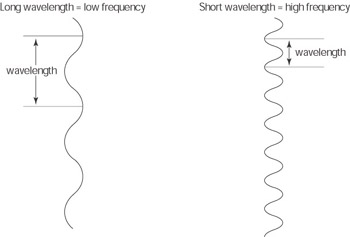
Figure 8-11: Wave cycle and frequency
Low-frequency signals have long wavelengths because it takes longer for each wave cycle to pass a given point. The signal from your WLAN hardware has a very short wavelength: 2.4 billion wave cycles per second for 802.11g and 802.11b (2.4 GHz), and 5 billion cycles per second for 802.11a (5 GHz).
An antenna can increase the strength and range of a signal. This is called gain, and it’s measured in decibels (dB). Gain is the amount that the output power of any signal is amplified compared to the input power.
An antenna can’t add power to a signal; it’s just a piece of metal. What an antenna does to create gain is focus the signal. A good analogy is a lighthouse, which uses its lenses to focus the light it creates into a bright beam. Similarly, antennas create gain by focusing electromagnetic waves and creating a stronger radio signal.
Improper mounting
Improper mounting of an antenna can create interference and multipath problems. It’s important that you follow the manufacturer’s instructions carefully to avoid these issues. Some antennas will only operate correctly when mounted in a specific manner. For example, some must be mounted vertically instead of horizontally. Failing to mount the antenna correctly may reduce your Wi-Fi signal coverage (see Figure 8-12).
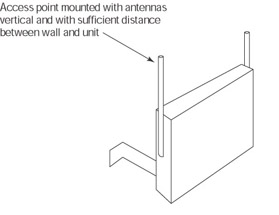
Figure 8-12: Proper mounting of an antenna
You must also follow instructions regarding distance from other antennas, walls, and roof. Mounting your antenna directly adjacent to another antenna may create problems from interference. Similarly, mounting an antenna or access point too closely to a wall, roof, or metal and concrete objects may create multipath interference (see Figure 8-13).
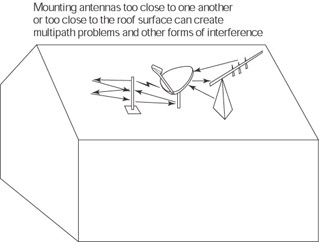
Figure 8-13: Multipath interference created by improper mounting
To avoid creating mutlipath problems due to improper mounting of an access point, be sure that the antennas have 6 to 8 inches of clearance from the walls or ceiling whenever you wall-mount an access point or omnidirectional antenna.
| Note | An omnidirectional antenna radiates its RF signal in all directions simultaneously. Omnidirectional antennas are standard on most access points. |
Grounding antennas
Whenever you install an external antenna, including a satellite or dish antenna, you must be sure it is properly grounded. If you fail to ground your system properly, a static charge can build up, creating interference and discharge that will damage your equipment.
The ideal method for properly grounding your antenna is through the house’s electrical system. This is a job for a professional installer, partly because of compliance requirements with local building codes, but also because inexperience in this area can lead to severe injury and even death.
| Caution | The previous warning is worth repeating: if you make a mistake while trying to ground your system, it could kill you. Don’t do this yourself unless you’re a professional installer and you know exactly what you’re doing. |
Grounding an antenna to a ground pole that has been driven into the ground is insufficient. The charge at the ground rod won’t be equal to the charge at the equipment, and the static discharge that results will destroy your equipment. Grounding through a building’s power supply will prevent this (see Figure 8-14)
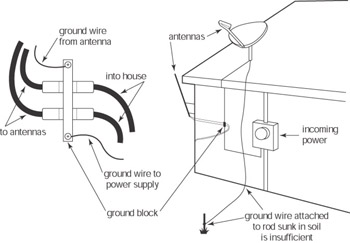
Figure 8-14: Grounding an antenna
Often, if a system has been without power, such as after a blackout, or if it’s been shut down for a significant period, a static charge can build up and cause interference once you power the system up again. You can correct this by manually discharging the static charge in the antenna cable.
| Caution | Make sure that you turn off power at both ends of the antenna cable in the event that there is powered equipment at both ends. |
To do this, you must first turn off all of the power to the system. After you have verified that the power is off, remove the antenna cable from the back of your access point or satellite modem. While holding the cable, touch your thumb to the center pin of the cable (see Figure 8-15). This should eliminate the static in the line. Then you can reattach the cable and restore the power.
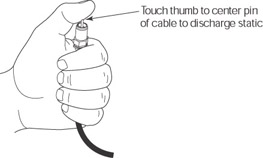
Figure 8-15: Manually discharging static
Proper grounding protects your equipment from lightning strikes as well as damage or interference from static charges. Many wireless service providers require that your installer ground the antenna or your warranty will be voided.
Delineating the Fresnel zone
If you have an outdoor line-of-site connection between two antennas, one important thing you have to consider is the Fresnel zone. Named for the French physicist Augustin-Jean Fresnel (pronounced fray-nel), the same man who designed the lenses first used in lighthouses, the Fresnel zone is the pattern of RF radiation between two antennas (see Figure 8-16). The Fresnel zone is shaped liked an elongated ellipse and must remain free of obstructions in order for a line-of-site connection to operate correctly.

Figure 8-16: The Fresnel zone
Objects, including trees, that extend into the Fresnel zone between two antennas will cause increased signal attenuation or interference (see Figure 8-17). Generally, in order for a link to operate efficiently 60 to 80 percent of the Fresnel zone must remain free of obstructions. You can accomplish this by mounting your antenna high enough to allow the Fresnel zone to remain above objects in the signal path.

Figure 8-17: The Fresnel zone must remain free of obstructions.
The size of the Fresnel zone depends upon the distance between the antennas and the frequency of the signal. For 2.4 GHz Wi-Fi, it is roughly 14 feet for a link distance of one mile and 10 feet for a half-mile link. For short-distance links, allow at least 10 feet for the Fresnel Zone, which should provide you with plenty of wiggle room when planning the link.
Interference from trees
Trees are a possible source of interference in outdoor links. Thick vegetation can contribute to Wi-Fi signal attenuation. This is partly because trees, like many living things, are almost 80 percent water (the leaves at least) and water can slow a 2.4 GHz signal.
| Note | When the 2.4 GHz RF radiation passes through water, the signal loses some of its power, which is transferred to the water as heat. This is why a microwave oven (also 2.4 GHz) can boil water. |
When you plan an outdoor link between buildings, make sure that you have an unobstructed line of site and that trees, shrubs, or heavy vegetation will not obstruct the signal. If you do your planning during the winter, remember that while a link may work fine when trees are bare, come spring, you may be in for a surprise when the leaves return and the signal degrades (see Figure 8-18).
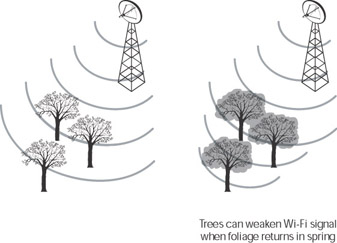
Figure 8-18: Interference from trees
EAN: 2147483647
Pages: 145